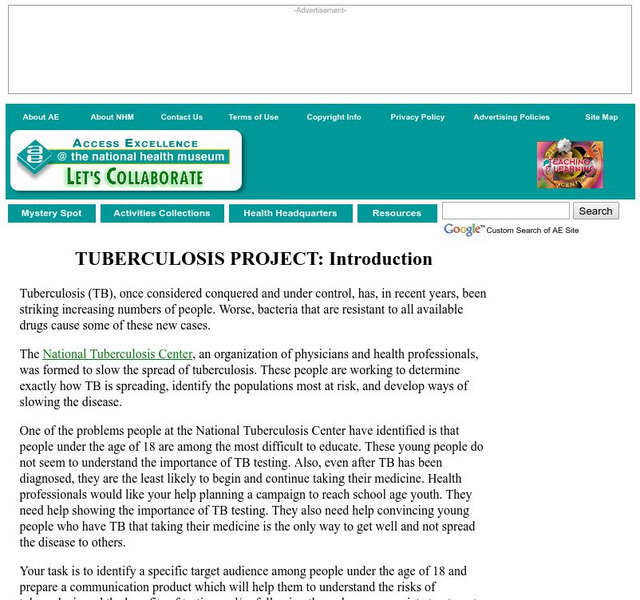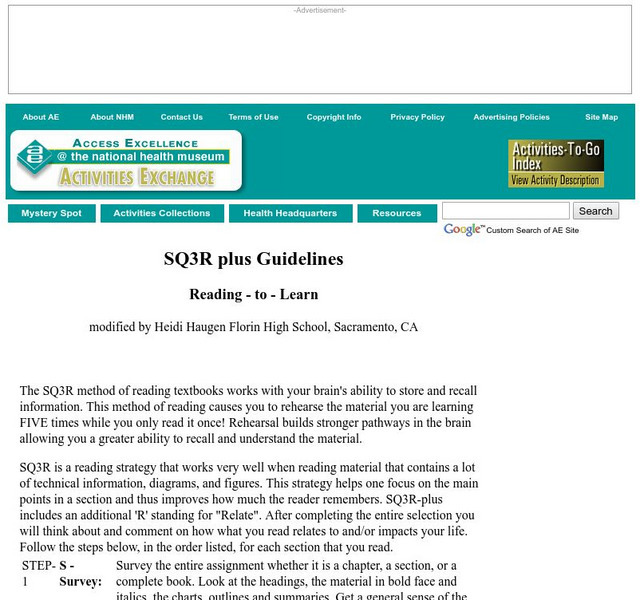National Health Museum
Access Excellence: Becoming a Scientist
Access Excellence invites you to explore the life of a scientist, career paths, and activities that allow you to think like a scientist.
National Health Museum
Access Excellence: Structure of the Dna Molecule
Read a history of the discovery and study of DNA and its structure. Links to a graphic, other references, and classroom activities.
National Health Museum
Access Excellence: Use of Dna in Identification
At this site from Access Excellence, you can read a transcript from a lecture at the University of California, San Francisco by a biology professor discussing the use of DNA in criminal identification.
National Health Museum
Radioactivity: Historical Figures
A summary of the contributions of Wilhelm Roentgen, Antione Henri Becquerel, Marie Curie, and Ernest Rutherford on radioactivity.
National Health Museum
Access Excellence: Development of Polio Vaccines
This site is provided for by Access Excellence. Beginning with a good description of the symptoms and spreading of polio, as well as information on Franklin Delano Roosevelt's battle with polio, this article addresses the development of...
National Health Museum
Access Excellence: In Search of Real Science
The author of this paper discusses some of the challenges and problems encountered when teaching science and the scientific method to students. He provides links for some sample lessons. Site by Access Excellence.
National Health Museum
Access Excellence: The Mysteries of Aging: Is Diet a Contributing Factor?
An interesting article that discusses effects of diet on senescence (the deteriorative aspect of aging). Dietary restriction is found to slow senescence in lab rats.
National Health Museum
Access Excellence: Genetic Testing Health Care Issues
This interview with a health policy expert on the use of and future of genetic testing is from a symposium on DNA at the University of California at San Francisco.
National Health Museum
Access Excellence: Dna Dry Lab
This lab illustrates how the order of nucleotides in DNA determines the order of amino acids in proteins. Relates DNA function to that of RNAand provides an exercise to demonstrate how mutations may occur. Includes a lesson plan and...
National Health Museum
Access Excellence: Microbial Fermentations
At this site from Access Excellence you can read about the different kinds of microbial fermentation, their role in biotechnology, and the history of the process and how it is used. Includes links to more detailed information.
National Health Museum
An Alternative Way to Learn Lab Safety Rules
Directions that will allow students to collectively compile a list of safety rules.
National Health Museum
Access Excellence: Tuberculosis Project
This site from Access Excellence provides extensive information for both the student and the teacher addressing the problems of tuberculosis. Create a communication product which will help people under the age of 18 understand the risks...
National Health Museum
Access Excellence: Mystery Spot: Croak
Access Excellence provides this fictional interactive story that explores the possible reasons for a disappearing species of frogs. Follow the clues, and email your answer!
National Health Museum
Access Excellence: Sq3 R Plus
This site gives a description of the steps in the SQ3R method. It also gives details and examples of each step.
National Health Museum
Access Excellence: Teaching Radioactive Decay
This is a lesson plan involving the simulation of the radioactive decay of an imaginary substance.
National Health Museum
Access Excellence: Handwashing
Discusses how handwashing can prevent spread of infection if practiced regularly and properly.
National Health Museum
Access Excellence: Coevolution Simulation
This site from Access Excellence provides a lesson plan/lab activity for simulating coevolution. Flowers and straws represent the effect that beak size and shape would have on real pollinators.
National Health Museum
Access Excellence: Discovery, Chance, and the Scientific Method
An interesting article that describes the relationship between chance and controlled scientific research. Several famous scientific discoveries are discussed.
National Health Museum
Access Excellence: Making a Phylogenetic Tree Lesson Plan
Constructing phylogenetic trees may be a daunting task for students, but this lesson plan is a simulation of what molecular biologists must do to determine relationships. This plan is for students who have a good grasp of DNA structure...
National Health Museum
Access Excellence: Dna Sequencing (Dry Lab Activity)
This site is an advanced level hands-on activity to explain the Di-deoxy sequencing of DNA.
National Health Museum
Access Excellence: Determining Transpiration From a Schoolyard Tree
A good project to link math skills with ecology. Hands-on activies help students understand the role of trees in ecosystems.
National Health Museum
Access Excellence: Food and Calories Lesson Plan
This lesson plan from Access Excellence offers sample charts and an answer key which helps students guess the caloric content of a variety of foods and then check their answers.
National Health Museum
Access Excellence: Overview of Biotechnology
This webpage provides brief answers to a wide range of questions about biotechnology. The site also contains links to additional sites.
National Health Museum
Nhm: Restriction Maps to Cladograms Lesson
This lesson plan requires students to analyze DNA restriction maps to determine the differences in the sequence for several primates and humans. They then use the information to create a cladogram.





